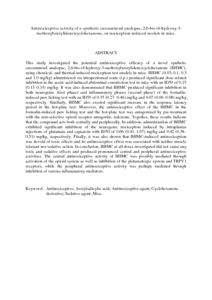Citation
Lee, Ming Tatt and Khalivulla, Shaik Ibrahim and Akhtar, Muhammad Nadeem and Tengku Mohamad, Tengku Azam Shah and Perimal, Enoch Kumar and Khalid, Mohamed Hanief and Omar Farouk, Ahmad Akira and Lajis, Md. Nordin and Israf Ali, Daud Ahmad and Sulaiman, Mohd Roslan
(2012)
Antinociceptive activity of a synthetic curcuminoid analogue, 2,6-bis-(4-hydroxy-3-methoxybenzylidene)cyclohexanone, on nociception-induced models in mice.
Basic & Clinical Pharmacology & Toxicology, 110 (3).
pp. 275-282.
ISSN 1742-7851; ESSN: 1742-7843
Abstract
This study investigated the potential antinociceptive efficacy of a novel synthetic curcuminoid analogue, 2,6-bis-(4-hydroxy-3-methoxybenzylidene)cyclohexanone (BHMC), using chemical- and thermal-induced nociception test models in mice. BHMC (0.03, 0.1, 0.3 and 1.0 mg/kg) administered via intraperitoneal route (i.p.) produced significant dose-related inhibition in the acetic acid-induced abdominal constriction test in mice with an ID50 of 0.15 (0.13–0.18) mg/kg. It was also demonstrated that BHMC produced significant inhibition in both neurogenic (first phase) and inflammatory phases (second phase) of the formalin-induced paw licking test with an ID50 of 0.35 (0.27–0.46) mg/kg and 0.07 (0.06–0.08) mg/kg, respectively. Similarly, BHMC also exerted significant increase in the response latency period in the hot-plate test. Moreover, the antinociceptive effect of the BHMC in the formalin-induced paw licking test and the hot-plate test was antagonized by pre-treatment with the non-selective opioid receptor antagonist, naloxone. Together, these results indicate that the compound acts both centrally and peripherally. In addition, administration of BHMC exhibited significant inhibition of the neurogenic nociception induced by intraplantar injections of glutamate and capsaicin with ID50 of 0.66 (0.41–1.07) mg/kg and 0.42 (0.38–0.51) mg/kg, respectively. Finally, it was also shown that BHMC-induced antinociception was devoid of toxic effects and its antinociceptive effect was associated with neither muscle relaxant nor sedative action. In conclusion, BHMC at all doses investigated did not cause any toxic and sedative effects and produced pronounced central and peripheral antinociceptive activities. The central antinociceptive activity of BHMC was possibly mediated through activation of the opioid system as well as inhibition of the glutamatergic system and TRPV1 receptors, while the peripheral antinociceptive activity was perhaps mediated through inhibition of various inflammatory mediators.
Download File
![[img]](http://psasir.upm.edu.my/24558/1.hassmallThumbnailVersion/Antinociceptive%20activity%20of%20a%20synthetic%20curcuminoid%20analogue.pdf)  Preview |
|
PDF ( Abstract)
Antinociceptive activity of a synthetic curcuminoid analogue.pdf
Download (185kB)
| Preview
|
|
Additional Metadata
Actions (login required)
 |
View Item |

